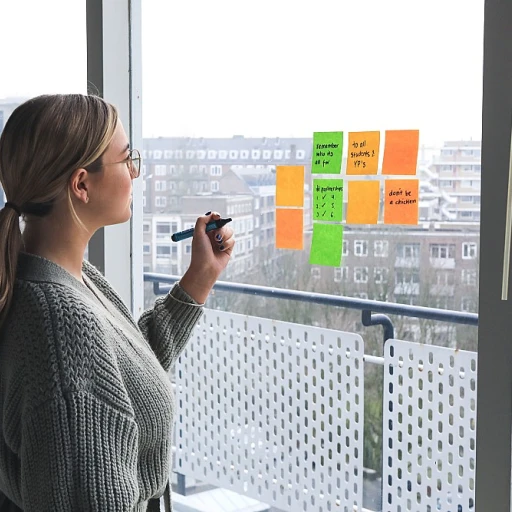The Evolution of Employee Surveys
The Advent of Digitalization in Employee Surveys
Employee surveys, a cornerstone of human resource strategies, have come a long way from their humble beginnings as paper-based questionnaires. For many years, organizations relied on manual processes to gather employee feedback, a method that was often cumbersome and time-consuming. The surveys involved face-to-face interactions or physical forms that needed to be filled out, collected, and analyzed manually. This traditional approach limited the frequency of feedback collection and often rendered the data obsolete by the time it was analyzed.
As we transitioned into the digital age, the implementation of online surveys marked the first substantial evolution in how organizations engaged with employees. These digital tools allowed for easier distribution and collection of feedback, increasing the frequency and reach of surveys while somewhat reducing the administrative burden.
However, despite these advances, the primary challenge remained: how to efficiently interpret vast amounts of data and translate it into actionable insights. This is where artificial intelligence has begun to make a significant impact, reshaping the landscape of employee surveys. By leveraging AI, organizations can now harness the power of data analytics to process feedback in real-time, offering invaluable insights into employee sentiment and workplace culture.
For instance, AI technologies facilitate more dynamic and iterative feedback cycles, enabling human resources to address concerns swiftly and effectively. As discussed further in
this article, AI's ability to analyze data at scale helps organizations identify trends and patterns that were previously undetectable, significantly enhancing the feedback process.
In the subsequent parts of this series, we'll explore how AI provides real-time feedback and insights, boosts employee engagement with tailored initiatives, and the critical role of natural language processing in understanding employee sentiment. Through detailed case studies, we'll show AI in action and look ahead to future trends and considerations. This journey through the evolving landscape of employee surveys demonstrates precisely how AI is transforming this essential HR function.
Real-Time Feedback and Insights
Harnessing Real-Time Feedback for Dynamic Insights
In today's fast-paced work environment, waiting for annual employee surveys to gather feedback is becoming increasingly outdated. Thanks to advancements in AI technology, organizations can now collect and analyze employee feedback in real-time, offering a more agile and dynamic approach to understanding the workforce.
AI-powered platforms enable employers to gather continuous feedback from their employees through various channels, such as chatbots and pulse surveys. This constant flow of information provides organizations with a granular view of employee sentiment, allowing them to address concerns promptly and foster a more positive work environment.
By utilizing machine learning algorithms, AI can identify patterns and trends within the collected data, allowing HR teams to make informed decisions based on real-time insights. This kind of intelligence was impossible with traditional survey methods, which often resulted in data that was outdated by the time it was analyzed.
Furthermore, AI can segment feedback according to departments, roles, or projects, helping organizations understand specific challenges each group may face. This targeted insight supports leaders in devising tailored strategies that accurately address the unique needs of diverse employee groups.
Incorporating AI in employee surveys also means feedback can feed directly into performance management systems. This ensures a continuous loop where employee feedback aids in real-time performance improvement. To understand how AI is reshaping feedback and performance management, you may find this
detailed blog post insightful.
Overall, the implementation of AI in employee surveys not only provides timely insights but also drives proactive engagement strategies, creating a work environment that is responsive to employees' needs and aspirations. As we explore further into how AI enhances employee engagement and its other roles in HR, the importance of real-time feedback facilitated by AI becomes even more evident.
Enhancing Employee Engagement
Boosting Engagement Through AI-Driven Surveys
Employee engagement is a cornerstone of a productive and thriving workplace. Traditional employee surveys, while effective in gauging general satisfaction and issues, often fall short when it comes to actively driving engagement. This is where artificial intelligence comes into play, revolutionizing how organizations can foster a deeper connection between employees and their work environments.
One of the most potent ways AI enhances employee engagement is by personalizing the survey experience. By analyzing individual responses over time, AI can tailor questions that resonate more with employees, digging deeper into their unique challenges and aspirations. This bespoke approach not only makes employees feel valued but also results in more meaningful insights that can be acted upon.
Furthermore, AI's capability to process vast amounts of data quickly allows for the analysis of patterns and trends that might go unnoticed in conventional surveys. By identifying common themes or concerns, AI enables HR departments to proactively address engagement issues, implementing targeted initiatives tailored to specific employee groups. This real-time feedback loop keeps employees engaged and supported throughout their journey in the organization.
The integration of natural language processing (NLP), which will be discussed further on, also plays a pivotal role in understanding the nuances of employee sentiment. By interpreting the subtleties of language, AI can uncover areas of concern or potential improvement that might not be evident from quantitative data alone.
For organizations looking to leverage AI effectively, it is essential to consider how these technologies can
boost employee engagement through smarter, more responsive surveys. By fostering an environment that actively listens and adapts to employee feedback, businesses not only enhance engagement but also strengthen their overall culture and productivity.
The Role of Natural Language Processing
Understanding and Analyzing Feedback with NLP
Natural Language Processing (NLP) plays a pivotal role in the transformation of employee surveys through AI. This technology is a subfield of artificial intelligence that focuses on the interaction between computers and humans through natural language. With its capabilities, HR teams can gain unprecedented insights into employee feedback, beyond the limitations of traditional surveys.
NLP algorithms are designed to understand the intricacies of human language, enabling them to decipher nuanced sentiments conveyed in open-ended survey responses. Where structured data might fall short, NLP thrives; it can differentiate between positive and negative feedback or even detect subtleties like sarcasm or apprehension in responses. This deep level of analysis provides rich qualitative data, ensuring that every voice is heard accurately.
Furthermore, the automation of these processes through NLP reduces manual effort and human bias in interpreting responses, resulting in faster and more objective outcomes. By harnessing NLP, businesses can provide personalized feedback and action plans, promoting a more engaging workplace environment.
In the previous sections, we discussed how employee feedback has evolved over time, with AI facilitating real-time insights into employee sentiments. Building on that, NLP serves as a powerful tool that refines these insights, allowing HR professionals and managers to make informed decisions about enhancing organizational culture.
Case Studies: AI in Action
Real-Life Applications of AI in Employee Surveys
In our exploration of the modernization of employee surveys, we've discussed how surveys have evolved over time and how real-time feedback and insights are reshaping the way organizations understand their workforce. Now, let's delve into some tangible examples where artificial intelligence has significantly transformed these processes, offering practical insights and paving the way for smarter HR strategies.
One remarkable instance is a global tech company that leveraged AI-driven surveys to enhance their diversity and inclusion initiatives. By utilizing sophisticated algorithms, they were able to identify nuanced patterns in survey responses that traditional methods often missed. This enabled them to craft more targeted programs to address specific concerns voiced by underrepresented groups within their workforce.
Another compelling case is a financial services firm that utilized AI tools to automate the analysis of open-ended survey questions. This approach, through natural language processing, not only saved significant time but also provided deeper insights into employee sentiment. These insights led to strategic changes in their internal communication processes, fostering a more transparent and engaging work environment.
Furthermore, a leading retail corporation harnessed AI to predict employee engagement levels by analyzing historical survey data along with real-time inputs. This predictive capability allowed them to proactively address potential issues affecting employee morale and turnover, aligning with our previous discussions on enhancing worker engagement and satisfaction.
These case studies merely scratch the surface of AI's potential in revolutionizing employee surveys. As the technology continues to advance, the possibilities for creating more responsive and caring workplace environments are endless, promising a future where employee voices are heard louder and clearer than ever before.
Future Trends and Considerations
Anticipating Tomorrow’s Employee Survey Trends
As organizations steadily adopt artificial intelligence in their employee survey strategies, it's crucial to consider the evolving landscape and future implications. The potential for AI-driven innovations in HR is vast, promising even more profound impacts on workplace dynamics and employee satisfaction.
In the coming years, we can expect a continuing shift toward more integrated feedback mechanisms. This means that surveys will likely become just one piece of a larger feedback puzzle, working in tandem with other AI tools designed to capture and analyze employee sentiment comprehensively.
Furthermore, we might witness the rise of more personalized survey experiences, thanks to advances in machine learning algorithms. These algorithms will enable HR teams to tailor questions to suit individual employee profiles, ensuring that feedback is relevant and actionable. Over time, AI systems could predict when an employee might be most receptive to providing feedback, thus increasing participation rates and the quality of data collected.
The role of AI doesn’t stop at data collection. With more sophisticated analytics and predictive modeling, AI can provide early warnings for potential employee dissatisfaction or even attrition, allowing organizations to preemptively address issues. Natural language processing (NLP) will continue to develop, giving machines an even deeper understanding of nuanced employee sentiments, as discussed previously.
Finally, as organizations strive for a more inclusive workplace culture, AI can assist in reducing bias in survey results. By anonymizing responses and highlighting discrepancies in participation or sentiment across various demographic groups, AI can guide HR leaders to foster a more equitable work environment.
In summary, the future of employee surveys promises to be more interconnected, personalized, and insightful, paving the way for proactive and inclusive workplace strategies.












